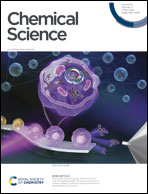Wide band gap selenide infrared nonlinear optical materials AIIMg6Ga6Se16 with strong SHG responses and high laser-induced damage thresholds†
Abstract
Infrared (IR) nonlinear optical (NLO) materials with strong NLO response, wide band gap and high laser-induced damage threshold (LIDT) are highly expected in current laser technologies. Herein, by introducing double alkaline-earth metal (AEM) atoms, three wide band gap selenide IR NLO materials AIIMg6Ga6Se16 (AII = Ca, Sr, Ba) with excellent linear and NLO optical properties have been rationally designed and fabricated. AIIMg6Ga6Se16 (AII = Ca, Sr, Ba) are composed of unique [AIISe6] triangular prisms, [MgSe6] octahedra and [GaSe4] tetrahedra. The introduction of double AEMs effectively broadens the band gaps of selenide-based IR NLO materials. Among them, CaMg6Ga6Se16, achieving the best balance between the second-harmonic generation response (∼1.5 × AgGaS2), wide band gap (2.71 eV), high LIDT (∼9 × AgGaS2), and moderate birefringence of 0.052 @ 1064 nm, is a promising NLO candidate for high power IR laser. Theoretical calculations indicate that the NLO responses and band gaps among the three compounds are mainly determined by the NLO-active [GaSe4] units. The results enrich the chemical diversity of chalcogenides, and give some insight into the design of new functional materials based on the rare [AIISe6] prismatic units.



 Please wait while we load your content...
Please wait while we load your content...